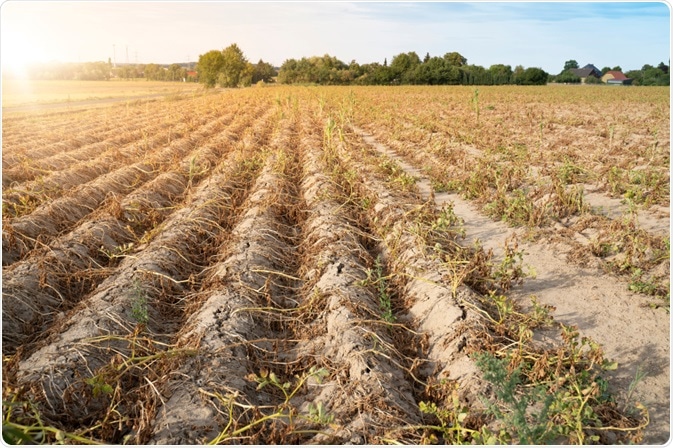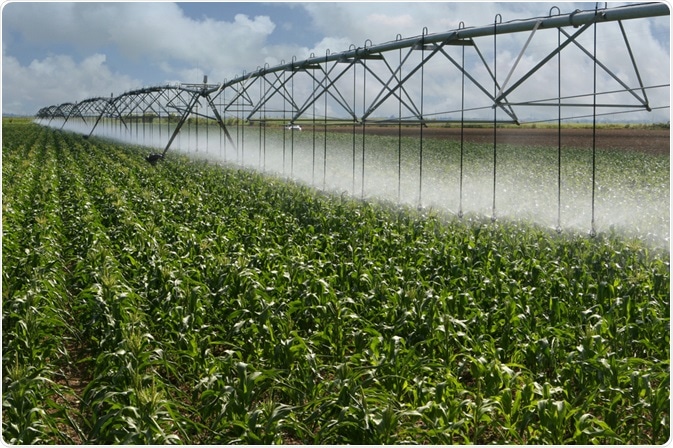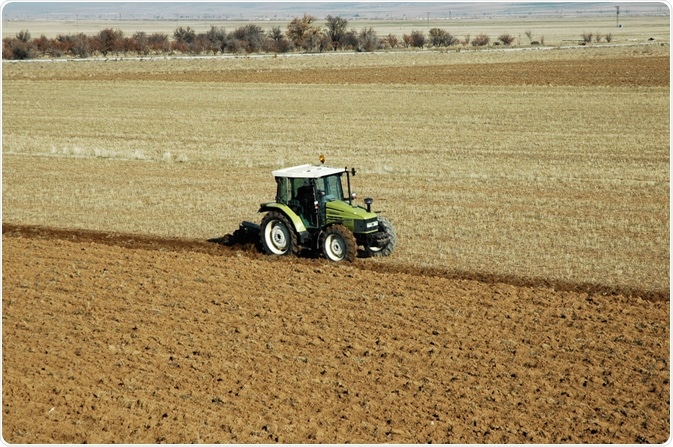Around the world, farmers are suffering due to worsening drought conditions. Warmer and drier conditions are leaving the land that was once fertile parched and unable to grow a viable crop or produce the grass needed to support livestock. Studies have shown that climate variation is responsible for at least a third of global crop yield variability between 1979 and 2008.

Image Credit: Tanja Esser/Shutterstock.com
With climate change becoming an issue of increasing urgency in all industries and global regions, scientists and various stakeholders are making marked efforts to develop innovative strategies to tackle the impact of rising temperatures.
For agriculture, this means implementing water management strategies, adopting the IoT, moving away from conventional farming methods, and reaping the benefits of genomics to overcome the issue of dry farmland.
Developing strategies to combat climate change
Numerous crop management strategies have proven to be useful in combating the impact of climate change on agriculture. Combinations of these strategies, discussed below, may be beneficial to helping farms produce crops in dry conditions.
These tactics may become increasingly important in years to come, as the population continues to increase, and demand for food grows with it. We discuss these strategies below.
Water management
Australia is one country that is demonstrating to the world how to cope with warmer temperatures when it comes to farming. The country is seeing rising temperatures, along with an increasing frequency and duration of droughts. This is causing hardship for Australian farmers who suffered decreased wheat yields between 2000 and 2015 due to climate conditions.
To tackle this, many Australian farmers have begun adopting water management systems to help combat the dry conditions caused by droughts. Rather than buying water, which is not environmentally friendly and adds extra costs to farmers suffering from a loss in crop yield, some farmers are digging boreholes to gain access to groundwater.
Further than digging boreholes, farmers are turning to more innovative methods to manage water with help from the Internet of Things (IoT).

Image Credit: REDAV/Shutterstock.com
The IoT and agriculture
The IoT has begun to infiltrate every industry. In agriculture, it will play a vital role in managing water to overcome drought conditions, as well as allowing farmers to take action to prevent falling soil conditions.
Moisture sensors have been developed that can collect data on the soil’s water content. Given that the amount of water required varies depending on the crop, the sensors can be linked with other connected technologies to automatically water crops when the moisture content falls below the required levels. This can prevent crop damage due to drought conditions, and it can also prevent water wastage from unnecessarily overwatering crops.
Additionally, rainwater sensors have been designed to assist farms situated in areas that are prone to drought. The sensors automatically collect data on rainfall and feed this information into connected water conservation systems. Water is collected and stored in times when it is not needed and then used to irrigate the land in times of drought.
Land sensors have also been created. These sensors communicate vital soil data, highlighting which areas of farmland may be lacking in nutrients or water before problems become large enough to damage the crop yield.
Allowing farmers to focus their efforts on the areas that need attention, streamlining their work to protect their crop yield, and reducing the necessary use of water.
Moving away from tilling methods
Conventional farming methods rely greatly on tillage, a method where the soil is churned (or plowed) to move the organic content and carbon to the surface, as well as to aerate the soil, providing bacteria and fungi with a source of oxygen, encouraging them to release nutrients.
However, conventional tilling methods have many problems. As well as contributing to soil erosion, and consequently, to soil loss, the method also reduces the water retention of the soil. This means that water drains more rapidly from tilled soil, resulting in less water being available to the crop. To address this, farmers have begun to move away from conventional tillage methods.
Conservation tillage has been developed to limit the downsides of conventional tillage, in encompasses three methods: no-till, ridge-till, and mulch-till. Studies have shown that water retention of soils farmed with conservation methods is greater, therefore, they have become a critical method for farmers in dry climates.
Read more about tillage here!

Image Credit: ompstock/Shutterstock.com
Increased disease resistance
Scientists are also using genomics to produce crops and livestock that survive better in drought conditions. Scientists have been using the method to look for characteristics of heat resistance as well as disease resistance to help farmers grow a successful crop even in challenging climates.
Recently, scientists were able to identify a group of genes that seem to be linked with drought-resistance in different species. It is thought that the genes that have been uncovered are responsible for allowing these plants to live in semi-arid conditions. It is believed that this discovery will be key to bioengineering new breeds of crops that can tolerate low-water conditions.
These strategies, among others that are expected to emerge as technology advances, combined will be essential to ensuring farmers can produce crops in dry climates. This will be key to tackling the looming food crisis as well as adapting to the changing global climate.
Sources:
- Hill, R., Horton, R., and Cruse, R., 1985. Tillage Effects on Soil Water Retention and Pore Size Distribution of Two Mollisols. Soil Science Society of America Journal, 49(5), pp.1264-1270. acsess.onlinelibrary.wiley.com/.../sssaj1985.03615995004900050039x
- Jacobsen, S., Jensen, C., and Liu, F., 2012. Improving crop production in the arid Mediterranean climate. Field Crops Research, 128, pp.34-47. www.sciencedirect.com/science/article/abs/pii/S0378429011003935
- Powlson, D., Stirling, C., Jat, M., Gerard, B., Palm, C., Sanchez, P., and Cassman, K., 2014. Limited potential of no-till agriculture for climate change mitigation. Nature Climate Change, 4(8), pp.678-683. www.researchgate.net/.../273621217_Limited_potential_of_no-till_agriculture_for_climate_change_mitigation
- The ‘real secret’ of how to farm in a hotter, drier climate. Jamie Smyth. The Financial Times. https://www.ft.com/content/c23403c0-ad30-11e8-8253-48106866cd8a
- Yang, X., Hu, R., Yin, H., Jenkins, J., Shu, S., Tang, H., Liu, D., Weighill, D., Cheol Yim, W., Ha, J., Heyduk, K., Goodstein, D., Guo, H., Moseley, R., Fitzek, E., Jawdy, S., Zhang, Z., Xie, M., Hartwell, J., Grimwood, J., Abraham, P., Mewalal, R., Beltrán, J., Boxall, S., Dever, L., Palla, K., Albion, R., Garcia, T., Mayer, J., Don Lim, S., Man Wai, C., Peluso, P., Van Buren, R., De Paoli, H., Borland, A., Guo, H., Chen, J., Muchero, W., Yin, Y., Jacobson, D., Tschaplinski, T., Hettich, R., Ming, R., Winter, K., Leebens-Mack, J., Smith, J., Cushman, J., Schmutz, J. and Tuskan, G., 2017. The Kalanchoë genome provides insights into convergent evolution and building blocks of crassulacean acid metabolism. Nature Communications, 8(1). https://www.nature.com/articles/s41467-017-01491-7
Last Updated: Sep 5, 2022